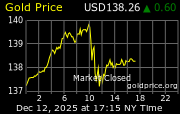gold price advanced $7.00 to $1,623 per ounce Friday morning after news that U.S. gross domestic product rose at a 1.3% annualized
 The gold price advanced $7.00 to $1,623 per ounce Friday morning after news that U.S. gross domestic product rose at a 1.3% annualized pace in the second quarter – well below market expectations of 1.8%. The price of gold was also boosted by the fact that President Obama and House Republicans remain unable to forge an agreement to raise the debt ceiling. A waning economic recovery and ongoing worries over sovereign debt – in not only Europe, but now the United States – continue to support the gold price.
The gold price advanced $7.00 to $1,623 per ounce Friday morning after news that U.S. gross domestic product rose at a 1.3% annualized pace in the second quarter – well below market expectations of 1.8%. The price of gold was also boosted by the fact that President Obama and House Republicans remain unable to forge an agreement to raise the debt ceiling. A waning economic recovery and ongoing worries over sovereign debt – in not only Europe, but now the United States – continue to support the gold price. Worries over a slowdown in consumer spending over the balance of 2011 will not only keep the Federal Reserve on hold for the balance of the year, but also raises the possibility of a new round of quantitative easing. The prospect of additional asset purchases by the Fed will likely support gold prices.
With the U.S. debt ceiling debate continuing to dominate financial headlines, several strategists discussed the implications for the gold price in recent notes to clients. TD Securities’ Senior Commodity Strategist, David Bouckhout, noted that with no deal in sight, investors have flocked to the yellow metal. “The partisan politicking in the US Congress surrounding the debt ceiling and other key fiscal issues is unlikely to inspire investors to take risky bets at this point,” he asserted. “As such, gold is a solid bet given its safe-haven characteristics.”
In the event that a debt ceiling agreement is reached, Bouckhout predicted that the price of gold would fall materially. However, he did not believe the gold price decline would “precipitate a sharp and prolonged sell-off.”
“We suspect a debt ceiling agreement would push gold down some $30-60/oz,” Bouckhout continued, “but with underlying monetization, inflation, European debt and US dollar concerns still very much in play, we don’t expect gold to stay low for long.”
Another firm to reiterate its bullish stance on the price of gold was Dundee Securities, which raised its gold price forecasts over the next several years. The firm lifted its average gold price estimate in 2011 to $1,526 from $1,476, and in 2012 to $1,750 from $1,573 per ounce. Ron Stewart, Head of Research at Dundee, wrote in the firm’s report that “We remain confident in the price of gold as the likelihood of a weaker greenback or a lack of trust in paper currencies is expected to continue to generate sustained demand for bullion.”
Stewart went on to say that “We suspect an anemic U.S. economy (due to reduced government spending) could hurt many industries, resulting in the yellow metal, bullion-backed ETF’s, and the underlying equities to be seen as a logical destination for investors seeking shelter from the global economic storm.”

































